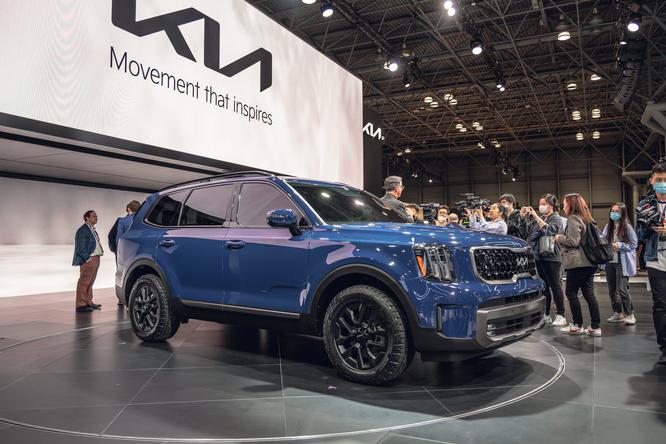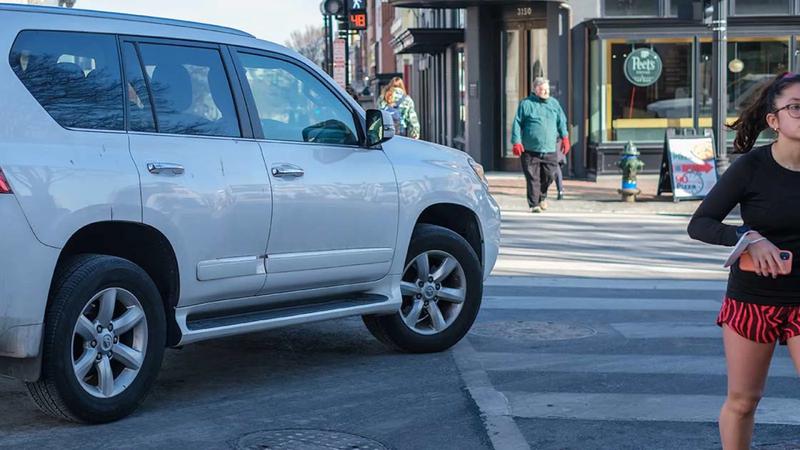Another big SUV that got a refresh at this year’s New York International Auto Show (NYIAS) is the Kia Telluride, which is the sister car to the Hyundai Palisade that also got a facelift. Kia’s three-row SUV was first introduced to the world back in January 2019 and was given a slight update last June.
This is the first major facelift for the Telluride, and the major changes are clear to see when viewing the vehicle from the front. The SUV gains a new bumper with a more clearly defined lower section that houses the smaller air intakes. In this area, you’ll also note that the fog lamps are now stacked on top of each other rather than being arranged horizontally, while the vertical faux inlets at the corners are more subtle in appearance.
Another notable change is the Telluride’s headlamps, with each cluster now featuring two vertical elements placed side by side. The rectangular daytime running light signature has been replaced with vertical lines within each headlamp as a result. If you can pull your eyes away from these attention-grabbing revisions, you’ll also notice that the brand’s tiger nose grille has been slightly reprofiled with a more pinched centre section and there’s a new pattern for the insert.
The new face certainly appears to be tidier than the pre-facelift model, and this approach is also carried to the rear. As before, there are still two-piece taillights that flow down the sides of the SUV, but there are now much slimmer in appearance and have a different light signature. The new taillight clusters also lose their reverse lights, which have been relocated to the bottom portion of the new rear bumper together with the reflectors.
The rear lower apron attempts to mimic what’s at the front by creating a blocky look and is joined by a body-coloured skid plate instead of a silver one. A new font type is also used for the model script on the tailgate, and Kia’s latest logo design is finally being used for the Telluride. Kia also notes the door garnish trim has been revised and there are new exterior colours and wheels to choose from.
Moving inside, we find a tweaked dashboard design that now has flatter air vents in the centre. This is necessary to create room for the new frame integrated into the dash that houses the displays, of which there are two of them. Both measure 12.3 inches and act as the digital instrument cluster as well as a touchscreen for the infotainment system (this is an upgrade from 10.3 inches previously). A new steering wheel and revised interior colours are the only other changes inside the cabin.

For the 2023 model year, Kia is offering two new “adventure-ready” trim levels in the form of the X-Line and X-Pro (both pictured here). The former adds on a unique grille design with an insert that has a pattern akin to the number two in Roman numerals, plus more robust roof rails, body-colour door handles, 20-inch wheels, X-Line badging and X-Line embossing on the front seat backrest.
The X-Line also gains 10 mm more ground clearance for improved approach and departure angles, a tow mode for optimised trailering performance and an improved traction control system. Meanwhile, X-Pro gets the same goodies as the X-Line, but swaps out the big wheels for 18-inch units and matching Continental all-terrain tyres, X-Pro badging and seat embossing, a 110-volt inverter outlet in the boot and increasing towing limit of 2,495 kg (5,500 pounds) from 2,268 kg (5,000 pounds).
As for equipment upgrades, the Telluride can be optioned with a digital rearview mirror with HomeLink as well as a smart powered liftgate with “auto close” functionality. Just like the latest Palisade, there’s digital key support so owners can unlock and start the car using compatible iPhones, Apple Watches and Samsung Galaxy devices.
In-vehicle Wi-Fi hotspot is also available, along with the Kia Access App for vehicle telematics, a 10-speaker Harman Kardon sound system, wireless charging, a head-up display that is now 10 inches rather than 8.5 inches, Driver Talk, Rear Occupant Alert and up to six USB-C charging ports (updated from USB-A).
The Telluride’s list of safety and driver assistance systems also gets an update to include two new features, namely Intelligent Speed Limit Assist with maximum speed sign recognition, and Forward Collision Avoidance – Junction Turning, which automatically applies the brakes when the system detects oncoming vehicles while turning left at an intersection and believes a collision is likely.
Both systems join several other additions like navigation-based Smart Cruise Control, Highway Driving Assist 2 (semi-autonomous driving; HAD 1.5 is standard), Forward Collision Avoidance – Junction Crossing (when passing through an intersection), Forward Collision Avoidance – Lane Change Oncoming (provides steering input to prevent a collision with oncoming vehicles), Forward Collision Avoidance – Lane Change Side (prevents side collisions with steering input) and Forward Collision Avoidance – Evasive Steering Assist.
Everything else that was fitted to the pre-facelift Telluride makes a return too, including Forward Collision Warning, Forward Collision Avoidance Assist with Pedestrian Detection, High Beam Assist, Lane Departure Warning, Lane Keeping Assist, Blind Spot Collision-Avoidance Assist-Rear, Blind Spot View Monitor, Driver Attention Warning, Smart Cruise Control with Stop & Go, Rear Cross-Traffic Collision-Avoidance Assist, Parking Distance Warning, Surround View Monitor, Lane Following Assist and Safe Exist Assist.
Again, just like the Palisade, the Telluride maintains the same powertrain as the pre-facelift model, with a Lambda II 3.8 litre V6 GDI Atkinson cycle engine serving up 291 hp at 6,000 rpm and 355 Nm of torque at 5,200 rpm. This is routed to either the front or all wheels via an eight-speed automatic transmission, with up to six drive modes available (Smart, Eco, Sport and Comfort standard; Snow and AWD Lock are additions for vehicles with AWD).




